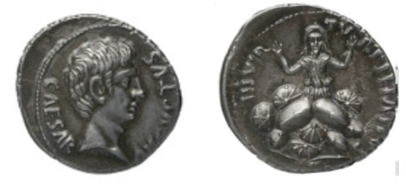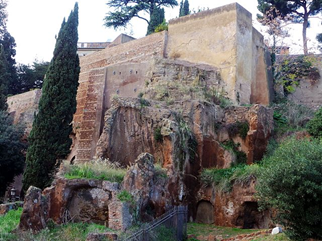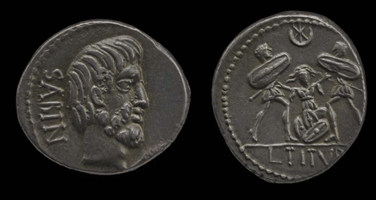Tarpeia: greedy traitor or feminist advocate? by Rebecca Preedy

1: Augustus, Rome, denarius, 19 BC-4BC, RIC 1² Augustus 299, Biblioteque Nationale de France
This denarius was minted in Rome under the emperor Augustus between 19 to 4 BC (RIC 1² Augustus 299). The obverse (shown on the left), as is typical with most Roman imperial coins, displays a portrait of the emperor surrounded by his name. The reverse (on the right) features the name of the moneyer, P. Petronius Turpillanus, and shows a woman, waist deep in circular objects and waving her hands in the air. These objects are shields, allowing us to identify the woman as Tarpeia being crushed to death by the shields of the Sabines.
The legend of Tarpeia was told variously by many Latin authors, including Livy, Varro and Propertius. However, most versions give the same basic plot points. It is told that in the time of Romulus, Rome was in a population crisis, so the Romans snatched away the women from the nearby settlement of the Sabines, forcing them to wed and therefore to expand the Roman population by having children. This mass kidnapping resulted in various battles as the neighbouring settlements attacked Rome. Finally, the Sabines themselves declared war, led by their king Titus Tatius.
At this point in the story, Tarpeia makes her entrance. A Roman, Tarpeia betrayed her people by opening their gates to the Sabine attackers. According to most versions of the story, the reason for her betrayal was greed; she asked the attackers to repay her with the gold they wore on their left arms. The attackers agreed, and once Tarpeia led them into the city, they gave her what they wore on their left arms. The catch, however, was that instead of giving her their jewellery the soldiers threw their shields upon her, crushing her to death. It is this moment that we see depicted on Augustus’ coin. Tarpeia is up to her waist in the Sabine shields, her arms flapping wildly. We can see that her eyes are wide and her mouth is open in a desperate scream. Once you know the story, the image is disturbing.
Tarpeia’s body was then thrown from (or in some accounts, buried at the bottom of) a steep cliff on the Capitoline hill of the city. This site became known as the Tarpeian rock and was used to execute traitors of Rome (Figure 2). Tarpeia thus became the epitome of shame and betrayal in the Roman world, and a warning to those who might follow suit.

2: The Tarpeian Rock on the Capitoline Hill.
The denarius depicting Tarpeia was possibly inspired by a Republican version minted in 89 BC by the moneyer L. Titurnius Sabinus, which depicted the Sabine king Tatius on the obverse (Figure 3). The moneyer probably chose this image because of the link between his name and the Sabines, and it has been similarly argued that Augustus chose the image of Tarpeia because it linked him to the Sabine strand of the Iulii family, thus legitimising his relationship to Caesar and strengthening his claim as emperor.

3: L Titurius Sabinus Rome, denarius, 89 BC, RRC 344/2b, British Museum 1902,0503.98
However, when we consider the context in which Augustus minted this coin, the object becomes far more sinister. This coin was first minted sometime after 19BC, a year before Augustus passed the first of several laws that promoted the production of legitimate children in Rome, by both rewarding women who produced multiple children and condemning those who bore illegitimate offspring. Part of the desire behind this law was the expansion of the Roman population. When we consider this context paired with the story of the Sabine women referenced by the coin, the image of Tarpeia becomes far more unsettling than simply legitimising Augustus’ claim to power. Instead, we see a woman being punished not simply for betraying Rome, but also for supporting the enemy who stood against the forced marriage and reproduction of their women. In this light, the coin can be said not only to support Augustus’ political ambitions, but also to warn against those who might wish to stand up against his legislation on marriage and childbearing. After all, this legislation was unsurprisingly quite unpopular, particularly among the equites classes. Interestingly, the moneyer of this coin, Turpillianus, also produced other very political coins for Augustus, including the famous kneeling Parthian to celebrate Augustus’ retrieval of the legionary standards lost at the Battle of Carrhae.
When we consider this context, does it make us think about Tarpeia differently? Did she really betray the Romans out of greed? The Latin authors were all men, writing hundreds of years after the events of the Sabine War. By this time, female luxury and greed were vilified by the Romans, and it is likely that this part of the story was added to reinforce the wickedness of Tarpeia’s betrayal. Livy even questions whether this part of the story was true, suggesting that Tarpeia may have demanded the Sabine shields deliberately in order to disarm them. Later versions, such as that of Propertius in the Augustan period, further play on Tarpeia’s immorality by adding in a love affair between her and king Tatius. Her betrayal here is even worse, since these versions label Tarpeia as a vestal virgin. So, to what extent was Tarpeia’s betrayal really based on greed or even lust? Did she actually betray her people for gold jewellery? Or was this just a plot devised by Latin authors to vilify the story of a woman standing up against the mass rape of a group of women by her people?
In any case, this coin reveals a sinister story. The context of its production suggests a link between the story of the Sabine women and that of the marriage legislation of Augustus. The coin itself stands as a warning to those opposed to the laws, using the death of Tarpeia as a violent visual example. Whether Tarpeia was in fact a greedy traitor, or simply playing a part in standing up against the violent forced marriage and reproduction of the Sabine women, we will never really know. However, I for one like to think that perhaps there was more to the story than the Latin authors might have us believe.
Bibliography
- Livy, Ab Urbe Condita Libri, Book I
- Varro, De Lingua Latina, 41
- Propertius, Elegies, IV.4
- Welch, T.S. (2005) The Elegiac Cityscape: Propertius and the Meaning of Roman Monuments (Ohio: Ohio State University Press)
- Rutledge, H.C. (1964) Propertius’ “Tarpeia”: The Poem Itself, The Classical Journal2:68-73
- Milnor, K. (2007) Augustus, History and the Landscape of the Law, Arethusa1:7-23
- Neel, J. (2019). Tarpeia the Vestal, Journal of Roman Studies,109:103-130.
List of images
- Augustus, Rome, denarius, 19 BC-4BC, RIC 1² Augustus 299, Biblioteque Nationale de France, accessed 24/02/22, http://numismatics.org/ocre/id/ric.1(2).aug.299
- The Tarpeian Rock on the Capitoline hill, Wikimedia Commons, accessed 24/02/2022, https://commons.wikimedia.org/wiki/File:TarpejischerFels.jpg
- L Titurius Sabinus Rome, denarius, 89 BC, RRC 344/2b, British Museum 1902,0503.98, accessed 24/02/22, https://www.britishmuseum.org/collection/object/C_1902-0503-98
